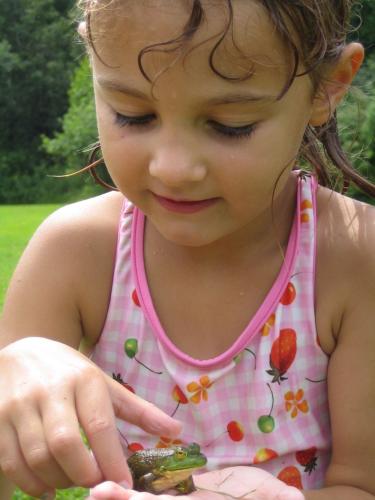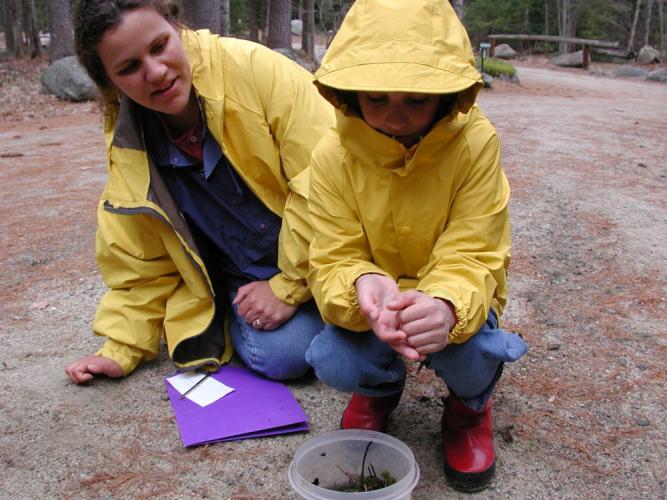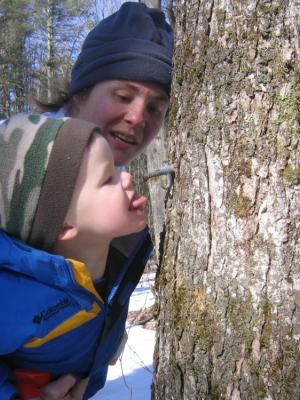Early Nature Lessons Can Last A Lifetime
- Tags:
- Education

Child gets to know a green frog. Photo Alex Chachkes
Teach Your Children Well
Once Upon A Time… all the best children’s stories began with those words.
Back then, children’s own best adventure stories took place in outdoor settings: exploring a spooky dark hemlock forest, a golden grasshopper-filled pasture, lichenfringed boulders, or the muddy shoreline of a pond or creek.
One perfect May morning, my threeyear- old daughter sat with me in the lap of a massive pine. From our pine-needle perch, we felt as much as heard a deep thumping noise resonate against our chests. What made the incredible sound?
“It’s a ruffed grouse beating its wings,” I told her.
Emily was silent, then grew wide-eyed as she whispered, “Daddy, how big is a rough grouch?” I smiled as she envisioned some ill-tempered hybrid of Big Bird and Oscar from Sesame Street.

When my kids were small, we wandered aimlessly outdoors. First, we ventured only in the backyard, picking dandelions or watching ants. Eventually, we ambled down our dirt road and crossed a stone wall to collect bright orange newts in neighboring woods. On summer nights, we caught fireflies. In time, we walked even farther, along with our dog and a fishing pole. We dug worms from the edge of the vegetable garden for fishing. We caught frogs and crayfish and watched bejeweled green dragonflies hover over scarlet cardinal flowers among the royal ferns on the banks of the Lane River.
The kids invented their own mythology of names for local animals, plants, and landmarks. Some place names endure to this day: the Dancing Lady Tree, Rooster Rock, Lookout Rock, Pride Rock.
As an environmental educator, some of my best training has come from children. Kids are curious. They ask great questions that begin with the words “why” or “how” and “when” rather than merely “what.” Kids notice little things, especially bugs. They are unabashed about inventing descriptive names for and ascribing magical powers to inanimate objects. Watching children discover nature reawakens the child within each one of us. Kids can teach adults how to experience the natural world with imagination and innocence we once possessed. They forgive us our hard science and infuse us with wonder.

In assembling photos to illustrate my point, I invariably thought of the parents who have not only shared photos, but who also share a world-view that children need to enjoy outdoor experiences in spite of minor inherent risks. The lifelong rewards of a childhood lived out of doors outweigh the potential for bee stings, mosquito bites, skinned knees, poison ivy, wet sneakers, and plenty of dirt under your fingernails. As the successful “Take Me Fishing” campaign photo caption goes, “Parents don’t save photos of their kids playing video games.”
With all the promise of a shimmering new summer ahead, now is the perfect time to take your kids for a walk in the neighborhood woods. Better yet, let them take you.
Get your pants muddy and your sneakers wet. Seize any opportunity to hold a wet frog, sniff pine needles, and study a clump of tiny wildflowers. Savor wild strawberries, startle at the sight of a garter snake, and listen to the evening flute song of a wood thrush.
You don’t need to name every flower you see and every bird you hear. That’s not the point. Just go outdoors to have fun, open your childlike sense of wonder. Don't obsess with hiking miles or reaching summits. Turn back when you’re only half-tired. A forced march spoils quality time. The small risks are worth the huge rewards of time spent outdoors together.
By encountering the natural world exclusively through televised nature features, children hear about a narrow universe of rare, threatened, and endangered habitats or dangerous predators— sharks, snakes, lions, and tigers and bears—oh my! Too often, they are left to assume that all wildlife are potentially deadly, and all forests are imminently threatened. Pervasive “extreme” stories foster irrational fear and concern in children during their most critical developmental stage for bonding with the natural world. Cumulative scary nature stories subtly change the way kids relate to the outdoors now and later as conservation-minded adults.
Educator David Sobel of Antioch New England Graduate School advocates a doctrine of “no environmental tragedy before fifth grade.” Sound advice.
Perhaps the best way to raise a next generation of ecologically literate citizens is simply to get our kids outdoors. Familiarity and experience with the outdoors as a child opens a window on the natural world that isn’t forgotten as an adult.
As my teenagers enter their twenties, they explore far beyond their childhood landmarks in the woods. While they have access to a dazzling array of video games, computer websites, television news, weather, sports, and entertainment, they still love to get outdoors. I believe they always will.
I’d like to think our aimless wandering during their tender years was not aimless after all. I hope their adult understanding of global environmental issues began years ago with an appreciation for nature in their own backyard.
